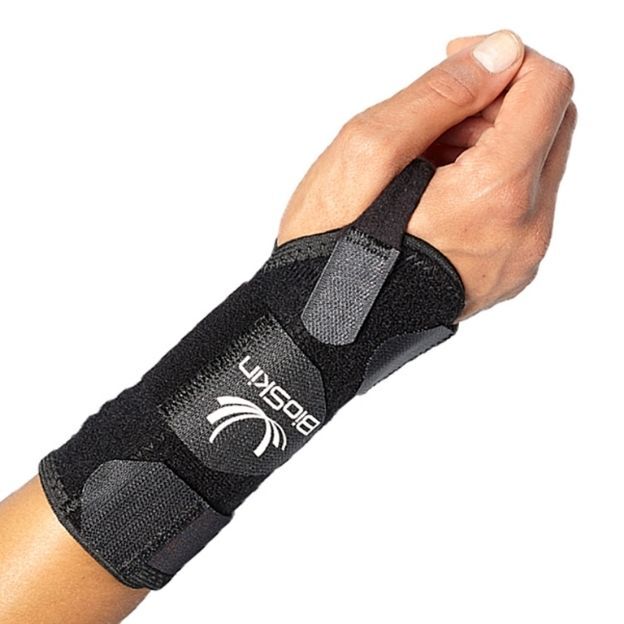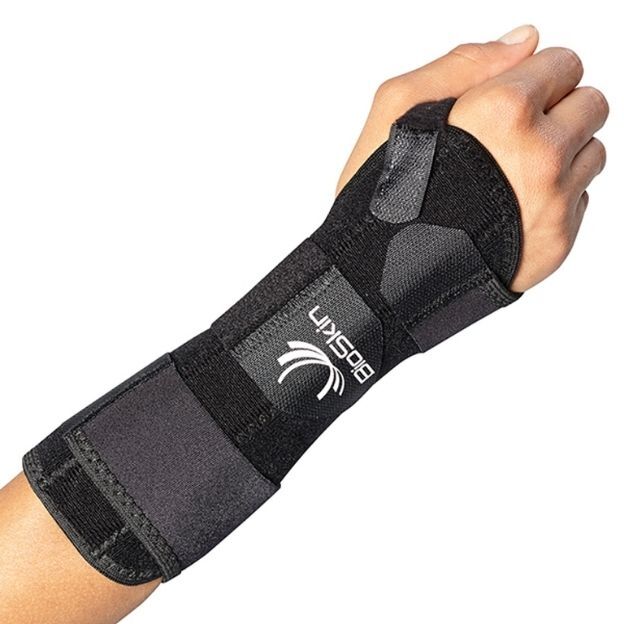Numbness in the thumb and first two fingers, pins-and-needles after typing, a jolt that wakes you at night. These are classic signs that your median nerve is under pressure. A carpal tunnel wrist brace helps by holding your wrist in a neutral position so the tunnel stays open and irritation eases.
Effective pain relief is a comfortable, secure fit you can wear through work, errands, and sleep. The goal of a carpal tunnel wrist brace is to steady your wrist, reduce swelling with gentle compression, and keep natural finger motion so you can get through daily tasks without flare-ups.
How a Carpal Tunnel Wrist Brace Reduces Symptoms
A carpal tunnel wrist brace keeps your wrist in a neutral position, which reduces pressure on the median nerve (the main source of numbness, tingling, and wrist pain in carpal tunnel syndrome). By minimizing flexion and extension, the brace helps calm inflammation around tendons and ligaments while easing the stress that builds from repetitive wrist and thumb motion.
Orthopedic surgeons and occupational therapists often recommend wearing wrist braces or carpal tunnel braces at night since many people sleep with bent wrists that increase nerve compression. This inflames the carpal tunnel.
Wearing a brace helps to inhibit this flexion, which then leads to reduced inflammation of the carpal tunnel. A night brace or metal splint maintains that neutral angle so symptoms don’t wake you.
Some users also benefit from a wrist support brace during repetitive tasks or light hand exercises, especially when early pain or tingling flares up. The key is adjustable support (straps that let you fine-tune compression without feeling too tight). That proper fit matters more than a “one size fits all” promise.
If you’re unsure how long or when to wear a brace, check with your doctor or therapist for personalized guidance. They can help you balance comfort, relief, and long-term improvement while protecting the joint’s natural motion and helping you get back to full strength safely.
What the Research and Guidelines Say
Clinical guidelines from the American Academy of Orthopaedic Surgeons (AAOS) list wrist orthoses and splints as a first-line, nonoperative approach for managing carpal tunnel pain. The goal is to maintain a neutral wrist position to limit pressure on the median nerve and allow surrounding tendons and soft tissue to recover.
Studies show that night splints, especially those designed to keep the wrist steady without cutting off circulation, can relieve symptoms with very low risk. Research comparing rigid splints and softer designs finds that comfort and adherence matter most. A brace that’s too firm or too loose won’t deliver results, so a proper fit with gentle, adjustable straps often leads to better wear time and less irritation.
Splints and braces don’t cure nerve compression or ligament strain, but they can significantly relieve discomfort and improve function when paired with activity changes and progressive exercises. Medical reviews also note that results vary by severity: mild or early cases often respond best to consistent use, while advanced or post-surgery cases may need additional treatment or rehab guidance.
For both men and women, finding the perfect fit, whether for the left hand or right hand, across multiple sizes, ensures consistent support without restricting the natural motion of the arm, forearm, or muscles. It’s a practical, low-risk tool that helps manage pain and swelling while protecting your wrist’s long-term health.
Brace Types and When to Use Them
Choosing the right brace is about matching support to your day. Start with the least help you need, then step up only when symptoms call for it.
Compression wraps/sleeves (mild, activity support)
If symptoms are mild or tied to repetitive tasks, begin here. Light compression supports tissues without limiting motion, so you can type, lift, or do short gym sessions with full finger use. Our low-profile wrap sits flat under sleeves and is easy to adjust for comfort.
Short cock-up splints (balanced support for daily wear)
When discomfort lingers through work and errands, move to a short cock-up splint. It holds the wrist near neutral to limit aggravating motion while keeping your hand functional. The compact profile fits under clothes, with removable stays so you can fine-tune support.
Long cock-up splints (maximum control, night use, flares)
If night pain wakes you or flares hit hard, a longer splint adds forearm leverage to maintain a steady neutral position. It’s a solid choice for sleep and tough days when you need more control, with a moldable stay to set the angle without going too tight.
Bioskin Picks: How We’d Match a Brace to Your Day
Start with the lightest support that keeps you comfortable, then step up only when symptoms ask for more control.
Boomerang Wrist Wrap: typing, light tasks, gym warmups

For mild, on-and-off soreness, our Boomerang adds gentle, circumferential compression without limiting finger motion. It fits either wrist and slides under sleeves for everyday use.
DP2 Cock-Up Wrist Splint (6.5"): daily wear for consistent symptoms or diagnosed CTS

When you need steadier neutral positioning in a compact profile, DP2 stabilizes the joint with medical-grade compression and removable, moldable stays. It’s available left or right, with multiple sizes for a dialed-in fit.
DP3 Cock-Up Wrist Splint (8.5"): night splinting or tougher daytime control

For overnight symptom control or bigger flares, DP3 adds forearm leverage to help you hold neutral longer, using a longer shell and bendable aluminum stay for secure, comfortable positioning.
All three use our breathable, lightweight, hypoallergenic materials, so you can wear support longer without overheating or irritation.
Put Neutral Wrist Support to Work Today
Your wrists do a lot for you. Now, it’s time to return the favor. Find the carpal tunnel wrist brace that fits how you live, from light compression for early symptoms to structured stability for lasting pain relief.
Choose your BioSkin design, size it for comfort, and start wearing it in a neutral position through your daily routine or at night. See the big difference in how your wrists feel every day.
Frequently Asked Questions
Do carpal tunnel braces help with carpal tunnel syndrome?
Yes, keeping the wrist in a neutral position can reduce pressure on the median nerve and ease carpal tunnel pain, especially at night. A brace supports that position so you can rest and move with less irritation.
When should I wear a brace for carpal tunnel pain—day, night, or both?
Start with night wear to prevent bent-wrist positions that aggravate symptoms. Add daytime use during repetitive tasks if symptoms flare. If numbness or tingling worsens, pause and reassess fit or talk with your clinician.


 British Pound
British Pound
